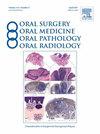Cone-Beam Computed Tomography Assessment of Bifid and Trifid Mandibular Canals: A Cross-Sectional Study
Oral surgery, oral medicine, oral pathology, oral radiology, and endodontics
Pub Date : 2023-06-19
DOI:10.3390/oral3020022
引用次数: 0
Abstract
The exact knowledge of the mandibular canal position is fundamental in oral surgery and implantology. Clinicians have to be extremely cautious when operating in close proximity to this structure in order to avoid damaging the neurovascular bundle. Several anatomical variations of the mandibular canal have been described in the literature, such as bifid or trifid structures. The use of cone-beam computed tomography (CBCT) offers a detailed representation of the inferior alveolar nerve path, albeit with some difficulties of identification when dental implants or metal prosthesis are present. The aim of this study is to retrospectively evaluate the prevalence and location of bifid/trifid mandibular canals (BMC/TMC) by CBCT in Italian patients. The screening phase involved 584 patients, only 238 enrolled (97 men; 141 women), with an average age of 51 ± 17.20. A total of 36 patients (15.25%) showed at least one bifid mandibular canal; only 2 patients (0.84%) showed a trifid mandibular canal. Overall, 12 patients (5.04%) presented this variation bilaterally. There was no association with the sex of the enrolled sample. In conclusion, the presence of BMCs and TMCs may be considered as a risk factor for the onset of neurovascular complications. Being aware of changes in the mandibular canal helps clinicians to prevent inferior alveolar nerve impairments that may occur during oral surgery and implantology.锥形束计算机断层扫描评估下颌二裂和三裂管:一项横断面研究
下颌管位置的准确知识是口腔外科和种植学的基础。临床医生在接近该结构时必须非常谨慎,以避免损伤神经血管束。文献中已经描述了几种下颌管的解剖变异,如二裂或三裂结构。锥形束计算机断层扫描(CBCT)提供了下牙槽神经路径的详细表现,尽管在牙种植体或金属假体存在时存在一些识别困难。本研究的目的是通过CBCT回顾性评估意大利患者下颌双裂/三裂管(BMC/TMC)的患病率和位置。筛选阶段涉及584例患者,只有238例入组(男性97例;141例女性),平均年龄51±17.20岁。36例(15.25%)患者至少有一根下颌双裂管;仅2例(0.84%)出现下颌三裂管。总体而言,12例患者(5.04%)出现双侧变异。这与入组样本的性别无关。总之,bmc和tmc的存在可能被认为是神经血管并发症发生的危险因素。了解下颌管的变化有助于临床医生预防口腔手术和种植过程中可能发生的下牙槽神经损伤。
本文章由计算机程序翻译,如有差异,请以英文原文为准。
求助全文
约1分钟内获得全文
求助全文
来源期刊
自引率
0.00%
发文量
0
审稿时长
1 months

 求助内容:
求助内容: 应助结果提醒方式:
应助结果提醒方式:


